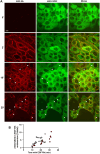Cell migration signaling through the EGFR-VAV2-Rac1 pathway is sustained in endosomes
- PMID: 39744818
- PMCID: PMC11828472
- DOI: 10.1242/jcs.263541
Cell migration signaling through the EGFR-VAV2-Rac1 pathway is sustained in endosomes
Abstract
Ligand binding to EGFR activates Rho family GTPases, triggering actin cytoskeleton reorganization, cell migration and invasion. Activated EGFR is also rapidly endocytosed but the role of EGFR endocytosis in cell motility is poorly understood. Hence, we used live-cell microscopy imaging to demonstrate that endogenous fluorescently labeled VAV2, a guanine nucleotide exchange factor for Rho GTPases, is co-endocytosed with EGFR in genome-edited human oral squamous cell carcinoma (HSC3) cells, an in vitro model for head-and-neck cancer where VAV2 is known to promote metastasis and is associated with poor prognosis. Chemotactic migration of HSC3 cells toward an EGF gradient is found to require both VAV2 and clathrin-mediated endocytosis. Moreover, sustained activation of Rac1, a Rho family GTPase promoting cell migration and a major substrate of VAV2, also depends on clathrin. Endogenous fluorescently labeled Rac1 localizes to EGFR-containing endosomes. Altogether, our findings suggest that signaling through the EGFR-VAV2-Rac1 pathway persists in endosomes and that this endosomal signaling is required for EGFR-driven cell migration.
Keywords: Cell motility; EGFR; Endocytosis; Rac1; VAV2.
© 2025. Published by The Company of Biologists.
Conflict of interest statement
Competing interests The authors declare no competing or financial interests.
Figures







Similar articles
-
VAV2 Drives EGFR-Mediated Rac1 Responses in Prostate Cancer.Mol Cancer Res. 2025 Aug 4;23(8):684-698. doi: 10.1158/1541-7786.MCR-24-0957. Mol Cancer Res. 2025. PMID: 40183768
-
Negative regulation of EGFR-Vav2 signaling axis by Cbl ubiquitin ligase controls EGF receptor-mediated epithelial cell adherens junction dynamics and cell migration.J Biol Chem. 2011 Jan 7;286(1):620-33. doi: 10.1074/jbc.M110.188086. Epub 2010 Oct 12. J Biol Chem. 2011. PMID: 20940296 Free PMC article.
-
VAV2, a guanine nucleotide exchange factor for Rac1, regulates glucose-stimulated insulin secretion in pancreatic beta cells.Diabetologia. 2015 Nov;58(11):2573-81. doi: 10.1007/s00125-015-3707-4. Epub 2015 Jul 31. Diabetologia. 2015. PMID: 26224100 Free PMC article.
-
Tiam1/Vav2-Rac1 axis: A tug-of-war between islet function and dysfunction.Biochem Pharmacol. 2017 May 15;132:9-17. doi: 10.1016/j.bcp.2017.02.007. Epub 2017 Feb 13. Biochem Pharmacol. 2017. PMID: 28202288 Free PMC article. Review.
-
The guanine nucleotide exchange factor Tiam1: a Janus-faced molecule in cellular signaling.Cell Signal. 2014 Mar;26(3):483-91. doi: 10.1016/j.cellsig.2013.11.034. Epub 2013 Dec 2. Cell Signal. 2014. PMID: 24308970 Review.
References
-
- Duan, L., Raja, S. M., Chen, G., Virmani, S., Williams, S. H., Clubb, R. J., Mukhopadhyay, C., Rainey, M. A., Ying, G., Dimri, M.et al. (2011). Negative regulation of EGFR-Vav2 signaling axis by Cbl ubiquitin ligase controls EGF receptor-mediated epithelial cell adherens junction dynamics and cell migration. J. Biol. Chem. 286, 620-633. 10.1074/jbc.M110.188086 - DOI - PMC - PubMed
MeSH terms
Substances
Grants and funding
LinkOut - more resources
Full Text Sources
Research Materials
Miscellaneous

